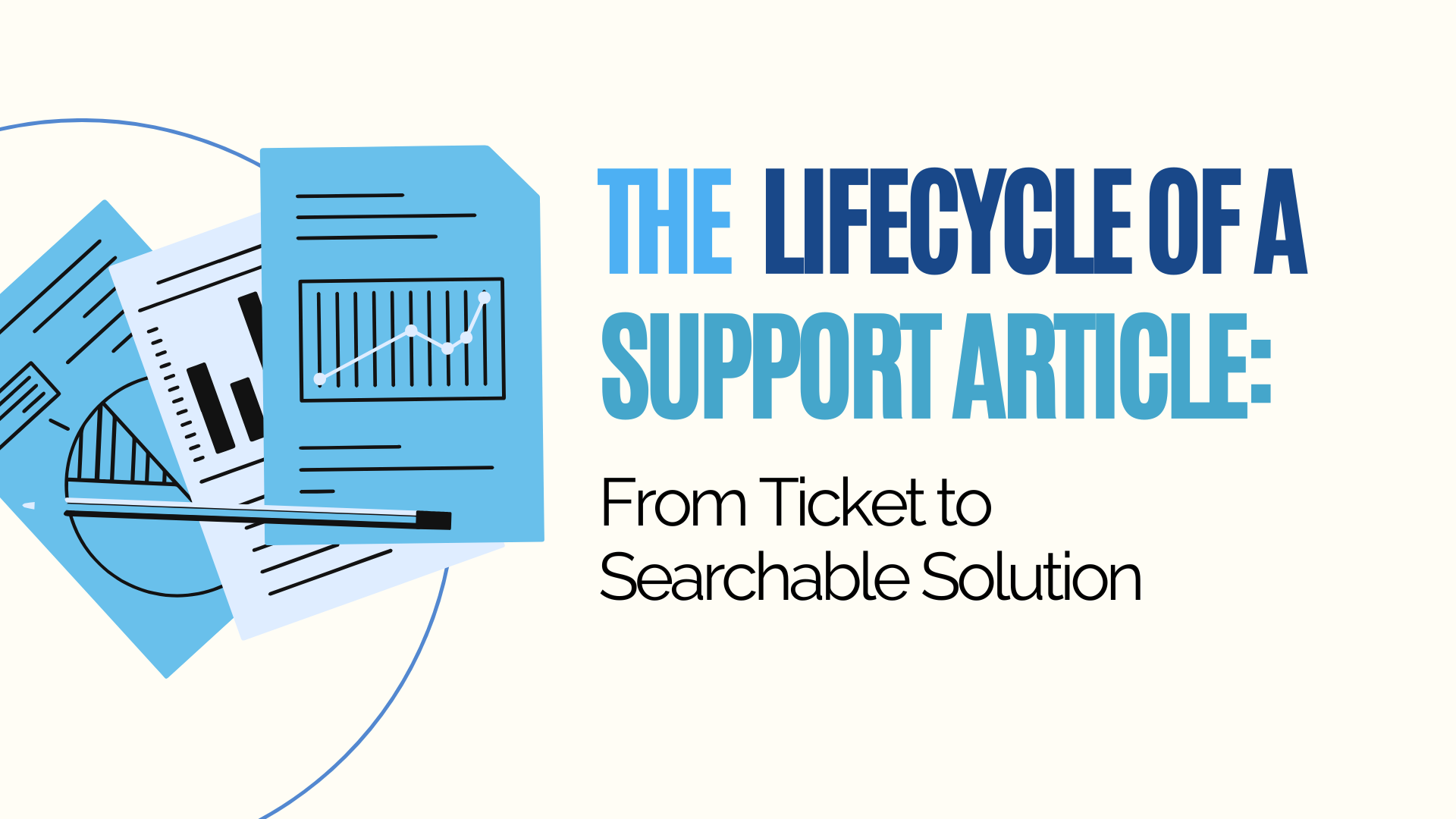BLOG
News, Guides, and Inspiration
Bits of usefulness, and bytes of updates

Help Center SEO: Optimize Articles for Google & Users
A well-optimized help center reduces tickets and boosts search visibility. By using clear structure, internal links, and fresh content, your support articles can rank in Google and actually help users. You don’t need to be an SEO expert—just apply a few best practices to make every article easier to find and use.
Read post

The 3-Minute Knowledge Base Audit: Is Yours Helping or Hurting?
Most knowledge bases aren’t broken because of bad content. They’re broken because no one checks if they still work. This post breaks down a simple 3-minute audit that helps you see whether your help center is actually reducing tickets—or quietly adding more. It shows how quick checks on search, content freshness, and deflection can reveal where self-service is failing and how to fix it fast, without rebuilding everything.
Read post

AI Writing Prompts for SaaS Content: How to Scale Quality Without Losing Your Voice
SaaS teams can scale content production without losing their brand voice by using reusable AI writing prompts that define intent, tone, and structure. The article explains how to build “super-prompts,” store them in HelpSite for easy reuse, and use them to speed up workflows while keeping content consistent and human.
Read post

How to Measure the Real ROI of Your Knowledge Base
This guide breaks down how to measure the real ROI of your knowledge base—going beyond page views to track metrics like ticket deflection, article usefulness, and time-to-resolution. It explains why these numbers matter for leadership buy-in, team recognition, and continuous improvement, showing how tools like HelpSite make it easy to see impact in real terms.
Read post

What Is AI Knowledge Base, and What It Is Not: Guide
AI knowledge bases use artificial intelligence to improve self-service support, making it faster to create, organize, and update helpful content. Unlike traditional knowledge bases, they offer features like AI-generated drafts, intent-based search, and automatic content optimization, saving teams time while improving customer experience. With the right human oversight, they reduce support costs, boost efficiency, and keep documentation accurate and relevant.
Read post

Support Article Lifecycle: From Ticket to Searchable Help
The support article lifecycle turns resolved tickets into lasting customer resources. By identifying repeat questions, drafting clear instructions, reviewing for accuracy, and publishing in an organized knowledge base, teams reduce support volume while improving customer satisfaction. Regular promotion, performance tracking, and updates ensure the knowledge base remains useful, searchable, and trustworthy.
Read post

Should You Gate Your Knowledge Base? Pros and Cons
Most businesses should avoid fully gating their knowledge base, since it limits SEO, frustrates users, and drives up support tickets. Gating makes sense for sensitive, compliance-driven, or premium content, but not for everyday FAQs or troubleshooting guides. A hybrid approach—keeping common answers public while protecting advanced or internal docs—strikes the right balance between control and accessibility.
Read post
.png)
Turn your help articles into a lead gen asset—here’s how
Your help center isn’t just for support—it can also attract and convert new leads. By aligning help articles with search intent, optimizing them like landing pages, adding subtle CTAs, and interlinking with marketing content, you turn FAQs into evergreen SEO assets. With analytics, social proof, and AI scaling, your knowledge base becomes a quiet but powerful driver of customer acquisition and trust.
Read post
.png)
Self-Service Gaps, Why Users Skip the Knowledge Base
Customers skip self-service when search fails, content feels unclear, or docs are outdated. HelpSite fixes this with predictive search, easy updates, and smart escalation to human support. Fresh, user-friendly content can cut tickets by up to 50% and make the knowledge base the go-to resource.
Read post
.png)
Fresh HelpSite Updates, Just for You!
HelpSite just launched smarter editing tools, including auto-saving, version history, assignments, and real-time notifications, available on Gold and Plus plans. Recent improvements include a smoother login flow, timezone options, and clearer notifications, all shaped by customer feedback. Coming soon are an upgraded editor and a code-free way to style articles with ready-made themes.
Read post
.png)
Why Ticket Deflection Shouldn’t Mean User Deflection
Ticket deflection reduces support volume by guiding users to self-service resources like FAQs and knowledge bases, but it should never feel like pushing customers away. Done right, it saves costs, boosts satisfaction, and helps lean teams scale without hiring more agents. HelpSite makes this possible with smart search, branded docs, and contact forms that suggest answers while still offering a clear path to human help.
Read post
.png)
The Rise of Lightweight Documentation Tools (a Good Thing)
Lightweight documentation tools are becoming popular because they strip away complexity, making it easy for teams to publish and find knowledge quickly. Unlike heavy platforms that slow teams down with steep learning curves and high costs, lightweight options focus on speed, simplicity, and affordability. This shift helps SaaS support leads, IT managers, and agencies save time, reduce support tickets, and provide a better experience for both teams and customers.
Read post
.png)
Knowledge Base Software: Why a Custom Domain Matters
A custom domain for your knowledge base strengthens trust, keeps your help center visually aligned with your brand, and improves the user experience. It also boosts SEO by keeping search traffic, backlinks, and authority on your own domain instead of your vendor’s. HelpSite makes this possible quickly, even on the free plan, with features like branded design, fast search, and smart contact forms.
Read post
.png)
The Most Overlooked Page in SaaS: Your Help Center
Most SaaS companies ignore their help center, even though it's a key tool for keeping customers happy and reducing support load. A strong help center builds trust, boosts SEO, supports sales, and can cut support tickets by up to 50%. Simple changes—like surfacing it in your main nav, writing clearer articles, and auditing for usability—can turn it into a quiet growth engine.
Read post
.png)
Knowledge Base vs Live Chat: Support Without the Overhead
Live chat offers instant help but quickly becomes costly with 24/7 staffing needs, burnout, and repeated simple questions. A knowledge base scales better, letting customers self-serve answers anytime while reducing tickets and agent workload. HelpSite makes this shift easy with AI-drafted articles, fast search, and multi-site support for lean teams.
Read post
.png)
Why Startups Need a Knowledge Base Before Hiring Support
Startups get overwhelmed with repeat support questions long before they can afford a dedicated team, making a knowledge base essential from day one. A simple, searchable help center lets founders scale answers without extra cost, saving time and reducing inbox overload. HelpSite helps startups launch one fast—with AI-generated articles, instant search, and a free plan that’s ready in under an hour.
Read post
.png)
Best Practices to Set Up a Private Knowledge Base (With SSO)
This guide covers how to set up a secure, easy-to-manage private knowledge base with SSO. It explains how to choose the right platform, structure content clearly, and keep access both safe and simple. Key tips include using SSO to boost adoption, avoiding shared passwords, and tracking usage to improve over time. With the right setup, your internal knowledge hub can stay useful—not forgotten.
Read post
.png)
SOP Software: Key Features to Look For in 2025 Guide
In 2025, the best SOP software is simple, fast, and built for real-world operations teams—not bloated enterprise tools. This guide breaks down the must-have features like smart search, clean UX, and multi-site support, while flagging common pitfalls to avoid. Whether you're managing internal docs or public help centers, the right tool can boost productivity and cut down costly errors.
Read post
.png)
How to Build an Internal Knowledge Base in Under a Day
If your team's knowledge is buried in scattered chats and inboxes, building an internal knowledge base can fix that in a matter of hours—not weeks. Tools like HelpSite let you create a searchable, secure hub of team know-how quickly, with smart features like auto-drafting and built-in search. Start small with essential categories and articles, then roll it out by linking in Slack, onboarding docs, or email signatures while gathering feedback to keep it useful.
Read post
.png)
Your HelpSite Just Leveled Up: Here’s What’s New!
This June, we launched powerful new features like one-click site cloning and introduced the HelpSite Blog to share expert tips and insights. Behind the scenes, we’ve rolled out several fixes to improve stability, formatting, and overall user experience. Plus, exciting updates like auto-save, version history, and article assignments are just around the corner!
Read post


